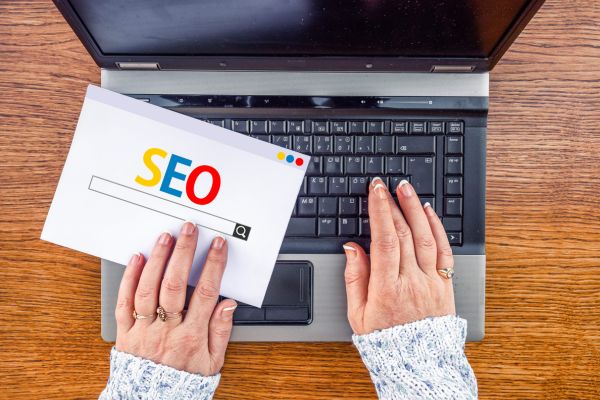Complete Local SEO Checklist to Improve SEO Rankings and Traffic

As our online interactions increasingly mirror our real-world activities, it’s no surprise that people turn to the web to discover local businesses and services.
With 1/3 of all searches now including specific locations, the demand for local information is at an all-time high. Notably, 97% of individuals rely on online platforms to unearth local companies, eclipsing all other sources.
The impact is profound; an astonishing 70% of mobile users directly dial businesses from search results, and nearly a third of local queries culminate in a purchase. Furthermore, the surge in terms like “where to buy” and “near me” by 200% in the last two years, coupled with a 250% rise in searches for “(store) near me,” underlines the growing importance of Local SEO strategies.
In this article, we present a comprehensive Local SEO checklist to empower your business, enhance your search engine rankings, and drive the right traffic to your doorstep.
Why Does Your Business Need Local SEO in 2025?
In 2025, your business needs Local SEO for several compelling reasons. With the advent of features like Google Maps and mobile search, proximity-based results are essential. Local SEO ensures your business appears prominently in these local searches, boosting your visibility and driving qualified traffic.
It also builds trust among potential customers as they see businesses with accurate NAP information and positive reviews. Given the rise of voice search and smart speakers, optimising for local queries becomes even more critical.
Therefore, in 2025, Local SEO is not just a strategy but a necessity to connect with local customers, enhance brand presence, and ultimately increase revenue.
15-Point Local SEO Checklist to Improve Your Local Business
Here is a detailed local search engine optimisation checklist on how to improve your local business:
Google My Business Profile Creation & Optimisation
Google My Business (GMB) profile optimisation is a fundamental step in local SEO. It involves both creating and fine-tuning your GMB listing to maximise its effectiveness. Begin by creating a GMB profile if you haven’t already, providing accurate NAP (Name, Address, Phone number) details, selecting relevant categories, and adding high-quality photos and videos.
Additionally, write a compelling business description and make sure your operating hours are up to date to improve GMB rankings. Ongoing optimisation includes regular updates, customer review management, and using Google Posts to showcase promotions and events. A well-optimised GMB profile enhances your local visibility, driving more traffic and potential customers to your business.
Prioritise Reputation Management
Prioritising reputation management through online reviews is vital for local businesses. Actively encourage customers to leave reviews on platforms like Google, Yelp, and social media. Positive reviews build trust and credibility. Equally important is responding to reviews promptly and professionally. Express gratitude for positive feedback and address any negative comments constructively.
By engaging with reviews, you demonstrate a commitment to customer satisfaction, which can influence potential customers positively and help in better online brand reputation management. This proactive approach not only enhances your online reputation but also increases the likelihood of attracting and retaining customers who value your business’s authenticity and responsiveness.
Keyword Research and Optimisation
Keyword research and optimisation, especially with a focus on local keywords, are essential for effective local SEO. Begin by identifying relevant local search terms with the help of good keyword research tools that potential customers are using to find businesses like yours. These keywords should include location-specific terms (e.g., “plumber in [city]”) to capture local intent. Incorporate these keywords naturally into your website content, meta tags, and Google My Business profile.
By doing so, you increase your chances of appearing in local search results, making it easier for nearby customers to discover and engage with your business. Accurate local keyword optimisation is a key driver of local SEO success.
Company’s NAP Consistency
NAP consistency, which stands for Name, Address, and Phone number consistency, is a critical aspect of local SEO. Maintaining uniform and accurate business information across all online platforms, directories, and listings is vital. Inconsistencies in NAP data can confuse search engines and potential customers, potentially harming your local search rankings.
Regularly audit and update your NAP details to make them correct and identical wherever your business is mentioned online. Consistency in this information not only helps search engines understand your business but also builds trust among customers, assuring them of your credibility and legitimacy, ultimately improving your online visibility and local SEO performance.
Use Structured Data
Structured data, such as local business schema markup, plays a pivotal role in local SEO. This specialised code, added to your website, provides search engines with explicit information about your business, including key details like your name, address, phone number, operating hours, and even customer reviews.
By implementing local business schema, you enhance your website’s visibility in search results and increase the chances of being featured in rich snippets or local knowledge panels. This not only makes your business stand out but also ensures potential customers receive vital information, ultimately boosting your local search rankings and driving targeted traffic to your business.
Create Local Backlinks
Local backlinks are essential for improving your local SEO. They encompass various elements, including local citations, local directories, and local public relations efforts:
- Local Citations: Acquiring local citations involves listing your business on online platforms, directories, and data aggregators. Popular sources include Yelp, Bing Maps, Yellow Pages, and more. These citations display your NAP information consistently across the web, strengthening your local presence.
- Local Directories: Submit your business information to local directories, chambers of commerce, and industry-specific listings. This expands your online footprint and provides quality backlinks, especially when these directories link to your website.
- Local Public Relations: Engaging in local public relations activities can earn you backlinks from local news outlets, blogs, or organisations. Consider sponsoring local events, participating in community projects, or sharing noteworthy business developments to attract these valuable local backlinks.
Together, these strategies help establish your authority and relevance in the local online landscape, improving your local SEO and driving more local traffic to your business.
Optimise Website
Website optimisation is integral to local SEO success. Start with boosting website speed, as slow-loading sites deter visitors. Optimise images, reduce unnecessary code, and use Content Delivery Networks (CDNs) to enhance loading times. User experience is vital; ensure a clean, intuitive design and easy navigation, making it effortless for visitors to find information.
Implement responsive, mobile-friendly design as an increasing number of users access websites via mobile devices. Utilise secure, HTTPS connections to instill trust and security. Regularly update and maintain your website to ensure it remains fast, user-friendly, and relevant to your local audience, ultimately improving your local search rankings and customer engagement.
Create Local Keyword-Based Content
Content creation is the bedrock of effective local SEO. Developing local-based, keyword-rich content is crucial to engaging your target audience and improving search engine rankings. Craft blog posts, articles, or web pages that revolve around local topics, events, or issues relevant to your community. Infuse these pieces with carefully researched local keywords to increase your chances of ranking in local search results.
These keywords should reflect the interests and intent of local customers seeking your products or services. Consistently producing valuable and informative content not only enhances your local authority but also establishes your business as an essential resource for the community, driving more local traffic and, in turn, boosting your local SEO performance.
Tailor Your Content As Per Location
When managing multiple locations for your business, it’s crucial to maintain a unique and authentic approach to your content strategy. Merely changing the location name while duplicating content across different locations is a missed opportunity for local SEO. Instead, create distinctive content for each location.
Tailor your posts, articles, and website content to reflect the local flavor, events, and specific needs of each community. This not only enhances your local relevance but also prevents duplicate content issues, which can negatively impact your search rankings. It also demonstrates your commitment to each community, building trust and engagement with local customers, and strengthening your local SEO efforts.
Provide a Google Virtual Tour With the Latest Images and Videos
Offering a Google Virtual Tour of your place is an innovative way to enhance your local SEO and engage potential customers. This feature, integrated into your Google My Business profile, allows users to explore your business virtually, gaining a deeper understanding of your offerings and environment. Regularly updating images and videos keeps your profile fresh and relevant, showing that your business is active and attentive to its online presence.
This feature not only entices potential customers but also helps in building trust. When people can see your space and what you offer, they are more likely to visit or contact you, ultimately boosting local traffic and conversions while improving your local SEO rankings.
Add FAQs Section to Solve Customer Issues
Being authentic and responsive to customer issues is a critical aspect of local SEO and customer satisfaction. To achieve this, consider providing a Frequently Asked Questions (FAQ) section on your website. Authenticity shines through when you address common customer queries and concerns openly and honestly. Not only does this instill trust in your audience, but it also helps in addressing issues proactively.
Ensure that your FAQ section covers a wide range of local-specific topics, from operating hours and payment methods to product or service details. Encourage customer feedback and use their questions to continually refine and expand your FAQ. By being authentic, addressing concerns, and maintaining an informative FAQ, you demonstrate your commitment to your customers, enhancing your local SEO and encouraging repeat business.
Work Local On-Page Optimisation
Local on-page optimisation is the process of fine-tuning individual web pages to enhance their local relevance and search engine visibility. This involves strategically having:
- Meta Tags (Title and Description): These are HTML elements that provide concise information about a webpage’s content, including relevant keywords, and are displayed in search results.
- Header Tags (H1, H2, H3, etc.): Header tags are used to structure content on a webpage, and they should include keywords to indicate the page’s main topics and subtopics.
- Image Alt Tags: Alt tags provide text descriptions for images on a webpage, helping search engines understand and index the images, which can enhance SEO.
- URLs: The URL structure should be clear, concise, and include keywords relevant to the page’s content, making it more user-friendly and SEO-friendly.
- Internal Links: These are links within your website that connect different pages and content. They help with navigation and distribute link equity, improving SEO and user experience.
Geo-tag images and incorporate local landmarks or locations in your content to strengthen your local connection. These on-page optimisations not only help search engines understand your locality but also improve your chances of ranking higher in local search results, ultimately driving more local traffic to your website.
Build Strong Social Media Strategy
A strong social media strategy is pivotal for local SEO and brand engagement. It involves maintaining an active presence on platforms like Facebook, Instagram, Twitter, and LinkedIn. Share local news, events, promotions, and user-generated content. Engage with your audience by responding to comments and messages promptly.
Consistency and authenticity are key. By adding a sense of community and building relationships with local customers, your business becomes more visible and trusted. Social signals from these platforms also influence your search engine rankings. A well-executed social media strategy not only enhances your local reach but also drives more targeted traffic to your website and storefront, boosting your local SEO efforts.
Bonus Tip: Track Local SEO Performance
Local SEO performance tracking is essential to assess the effectiveness of your local optimisation efforts. It involves monitoring key metrics, such as organic and local search rankings, website traffic, click-through rates, and conversion rates from local visitors. SEO reporting tools like Google Analytics and Google Search Console can provide insights into user behaviour and keyword performance.
Additionally, track the performance of your Google My Business profile, including clicks, views, and customer actions. Regularly reviewing these metrics allows you to refine your local SEO strategy, identify areas for improvement, and adapt to changing algorithms, ensuring your business remains competitive and visible in local search results.
Final Words
With the majority of people relying on online resources to discover local businesses and services, a robust local SEO strategy has never been more critical. The extraordinary conversion rates and the surge in “near me” searches underscore the untapped potential for businesses willing to invest in local optimisation.
This comprehensive Local SEO checklist 2025 offers a strategic roadmap to local search, boosts your online visibility, and attracts customers right to your doorstep. By optimising your Google My Business profile, curating engaging content, ensuring NAP consistency, and fostering a strong online reputation, you can stay ahead in the competitive local market. If you need more help, talk to professional Local SEO experts and see good results!
Remember, the commitment to an authentic, responsive, and user-centric approach will not only improve your search engine rankings but also build lasting trust and loyalty among your local customer base. In the dynamic digital landscape, Local SEO is your compass to navigate the road to success.
FAQs
What is the difference between organic SEO and local SEO?
Organic SEO focuses on improving a website’s visibility in general search results, while local SEO targets specific geographic regions to attract local customers.
How can I check the accuracy of my NAP information across different online directories?
Tools like Moz Local and Yext can help you identify and correct NAP inconsistencies across various online platforms.
Is it important to respond to negative reviews in local SEO?
Yes, responding to negative reviews is crucial. It shows potential customers that you care about feedback and are committed to addressing issues.
What’s the significance of Google Posts in local SEO?
Google Posts allow you to share promotions, events, and news directly in your Google My Business profile, enhancing your local visibility.
Should I focus on both on-page and off-page local SEO techniques?
Yes, a well-rounded local SEO strategy includes both on-page and off-page optimisations for the best results.
How can I get high-quality backlinks for my local business?
Partner with local organisations, sponsor events, or participate in community activities to earn valuable local backlinks.
What role do online reviews play in local SEO rankings?
Positive online reviews signal trustworthiness and customer satisfaction, which can positively impact your local search rankings.
Do I need a physical location to benefit from local SEO?
While having a physical location can be advantageous, businesses operating entirely online can still optimise for local searches by targeting specific geographic areas.
What are the best practices for optimising images for a Google Virtual Tour?
Use high-quality images, ensure they are well-lit, and showcase your business’s key features to create an engaging virtual tour.
Can I handle local SEO on my own, or should I consider hiring an expert?
You can manage some aspects of local SEO yourself, but consulting with an expert or agency can provide in-depth expertise and save you time and effort.
Calling all Marketers!
🔴 Are you tired of searching for the perfect job?
Whether you're into content writing, SEO, social media, graphic design, or video editing—full-time, freelance, remote, or onsite—we've got your back!
👉 We post over 30 job opportunities every single day. Yes, every day (all verified).
Join the most reliable and fastest-growing community out there! ❤️
And guess what? It’s FREE 🤑
✅ Join our WhatsApp Group (Click Here) and Telegram Channel (Click Here) today for instant updates.







